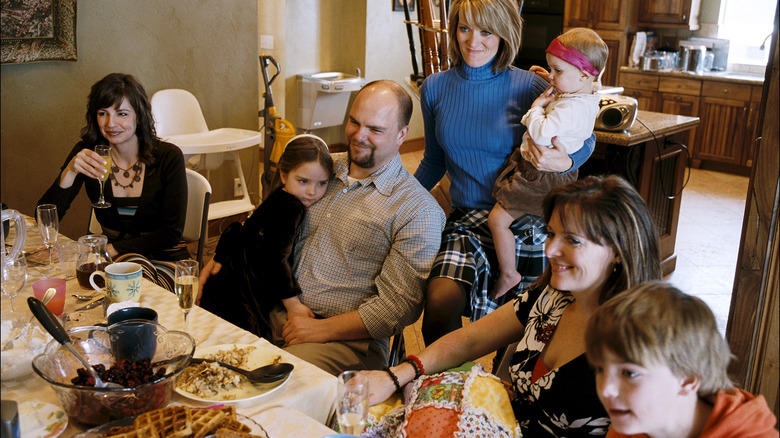Vees, Triads, Quads: The Different Types Of Polyamorous Relationship Structures, Explained
If you're a Gen Zer or even a young Millennial, you probably know at least one person in a polyamorous relationship. A 2021 study published to Frontiers in Psychology found that over 10% of Americans had been in a polyamorous relationship and more than 16% would be open to practicing polyamory.
Polyamory can mean different things to different people. Rachael Hope, a relationships writer and the editor of Polyamory Today, explains that the one thing all polyamorous relationships have in common is that at least one person in an intimate relationship has deep, meaningful relationships with more than one partner. Hope emphasizes that ethical, healthy polyamorous relationships require the consent of all partners involved.
For some, practicing polyamory means that one person has multiple long-term partners. For others, it can mean having one primary partner and other secondary partners. For still others, it can mean multiple partners who all have relationships with each other and function as one family.
If this sounds complicated, it's because it can be! We've put together this guide to help you understand common poly relationship structures, the values on which they operate, and the practices that make these relationships successful.
The difference between polyamory and ethical non-monogamy
The terms polyamory and ethical non-monogamy (ENM) are often used interchangeably, but they're not the same. Leanne Yau, a sex and polyamory educator, explains that ethical non-monogamy encompasses any relationship where all partners agree that they can see other people. So, polyamory is one kind of ENM relationship structure.
People practicing polyamory have multiple relationships based on mutual love and a solid commitment to each partner. However, people practicing other forms of ENM — such as swinging, monogamish relationships, and open relationships — are usually committed to one partner long term and hook up with other partners based on guidelines that both partners agree to.
Swingers are typically committed couples who have sex with other people as part of their own intimate relationships. Monogamish couples are mostly monogamous, but every once in a while, they have sex with other people, with the consent of their partner. People in open relationships are also mostly monogamous, but each partner has more leeway to have sexual or romantic relationships with others.
The difference between polyamory and polygamy
Many still confuse polyamory with the centuries-old practice of polygamy. In an article for Psychology Today, polyamory expert and researcher Dr. Elisabeth A. Sheff explains that polygamy is a specific marriage practice deeply rooted in certain ethnic and religious traditions and heterosexual norms. Polygamous marriages are typically only sanctioned between people of the opposite gender, and same gender marriages are often prohibited. Misogyny is a common undercurrent of polygamous marriages. In most cultures, only men can practice polygamy, while their wives are expected to support their decision. Wives often have little say in whether or not their husband marries another woman and little control over how the relationships function.
In contrast, polyamorous relationships are based on mutual respect, love, agency, and consent. Each partner has a say in their partners' other relationships to an extent, and all partners work together to make sure each other's needs are met. Additionally, people of all genders practice polyamory, and every partner has an equal amount of power regardless of their gender. And, unlike polygamy, polyamory is not tied to the institution of marriage.
The values of ethical polyamory
We'll say it again for those who still don't get it: Polyamory is not cheating! Poly relationships are built on a strong foundation of consent and radical honesty, as Elizabeth Brake explains in her essay for the book, "The Philosophy of Sex." Each partner is completely honest with all their partners about their physical and emotional needs and their other relationships, and they work with all partners to establish guidelines that work for everyone.
These guidelines may include how many partners each person can have, what sexual acts are allowed and not allowed, how much time needs to be spent with each partner, and how partners are involved with each other. New partners are informed about the previously established guidelines and are often invited to add new guidelines. All partners consent to the same guidelines and are informed of any changes.
Healthy poly relationships are highly ethical because they require an immense amount of honest communication and mutual respect rooted in shared values.
Why people choose polyamorous relationships
People choose to practice polyamory for the same reasons they choose any relationship — because it fulfills their wants, desires, and needs. As researcher and polyamory expert Dr. Elisabeth Sheff points out in an article for Greater Good Magazine, it's somewhat unrealistic to expect one person to fulfill all our wants, desires, and needs. People in monogamous relationships often crumble under the pressure to be everything for their partner.
However, people in poly relationships can go to multiple partners to get what they want and need. This puts less pressure on each person in the relationship. And having multiple partners means that when people's expectations don't match up — such as when one person has a much higher libido — they can find other partners whose expectations match theirs.
It also means that the responsibilities of a long-term partnership are spread among several people instead of just two. People in poly relationships often split expenses, housework, and childcare responsibilities and share the load of mental and emotional labor so that everyone feels seen, heard, and appreciated.
Additionally, many people find that having multiple intimate, long-term partners means having more people they trust who know them well enough to share hard truths. Because of this, they tend to have more opportunities to reflect on themselves and their behavior and to improve themselves.
The potential complications
No relationship comes without complications, and poly relationships are no exception. Jan Merrills, a therapist who works with polyamorous people, explains that one thing that can make poly relationships complicated is the sheer amount of planning. Making time for multiple partners, managing multiple schedules, and ensuring everyone gets the time they need is a lot. Each partner needs to have excellent time management skills and a lot of respect for the value of everyone else's time. If one partner thinks they're entitled to more time than the others or constantly double books themselves, problems can develop.
Poly relationships also require exceptional communication skills. Each partner needs to share what's on their mind, ask for what they need, and point out issues. They also need the listening skills to understand what their partners are saying and the willingness to work toward equitable solutions.
Jealousy can also complicate poly relationships, as being poly doesn't mean never becoming jealous. It does mean handling jealousy differently. Each partner has to be honest about their jealousy and work with their partners to identify the core issue.
Polycules: The many structures of poly relationships
Now that we've covered the basics, let's dig into the details of polyamorous relationship structures. Any committed, loving relationship that involves more than two people can be polyamorous. We can't possibly describe every relationship structure that exists, so we're covering the most common ones.
The first term you need to know is polycule. A polycule is a group of polyamorous people who are involved with each other. It can include all the people one person is in a relationship with as well as all the people they're in relationships with.
For example, if Jess and Garrett are dating, and Jess is also dating Marie and Seth, who are dating John and Jenny, everyone is in the same polycule. But a polycule may also consist of just a few people who are all in relationships with each other. If Jess, Garrett, Marie, and Seth are all dating each other, but no one else, then they're their own little polycule. If Garrett, with the permission of his polycule, decides to date John, who's also dating Jenny, then his polycule will overlap with John's polycule.
Confused yet? It'll make more sense when we explain some of the more common relationship structures: vees, triads, quads, solo-polys, and mono-polys.
Vees
Stephanie Sullivan, a licensed marriage and family therapist, explains that vee relationships involve one person dating two different people, who aren't dating each other. Vees get their name from the letter V, which is the shape you'd make if you draw a diagram to explain the relationship. The bottom of the V is one person, and each point at the top of the V is one of the people that person is dating. So, if Jess is dating both Garrett and Marie, but they aren't dating each other, the three of them are in a vee.
The person who is dating both of the other people in the vee, Jess, is known as the "hinge" or "pivot" in the relationship because she's the only connection between the other partners. Garrett and Marie are both "metamours," the term for the people dating the hinge/pivot.
The metamours in a vee relationship may be good friends or know each other casually. They could also be total strangers. However, the metamours are aware of each other because the hinge/pivot is transparent about dating two people.
Triads
When three people are all dating each other, that's a triad. Several people in triads shared with SheKnows that these relationships can start all sorts of different ways. Sometimes the metamours in a vee decide that they want to start dating as well, and they become a triad along with their hinge or pivot. So, if Garrett and Marie decide they want to date each other as well as Jess, all three of them can have a conversation and decide to become a triad.
It's also common for triads to form when a married or committed couple opens their marriage. They may open their marriage with the intention to add a specific third person, or they may set out to date different people and find that one person one of them is dating is the perfect match for both of them. Then, they can ask that person if they want to become a triad.
Triads can also form without an existing relationship between any of the partners. Sometimes single poly folks meet and fall for each other and form a triad from scratch.
Often, the boundaries and guidelines of triads are easier to set because everyone is dating each other. However, each partner still must make sure everyone's needs are getting met so no one partner feels left out.
Quads
Polyamorous relationships that involve four people dating each other are called quads. These relationships often form when two couples fall in love. Alysia Rodgers told Today that she and her husband, Tyler, had no idea what polyamory was until they fell in love with their best friends, Sean and Taya Hartless. After the two couples had been dating for a while, they decided to combine their separate families into one big family. This isn't the only way that quads can form, though. A triad can turn into a quad if all three partners decide they want to add another person to their relationship.
Sometimes quads function as a single family or household unit. Other times, quads maintain separate households, with certain partners — not all — living together, even though all partners in a quad are dating each other. This often occurs when a prior relationship existed to the quad forming, such as a couple or a triad.
Quad relationships require a lot of meticulous planning and open communication to ensure that time, energy, and affection are equally distributed among all partners. Issues can arise when the relationships that existed before the quad formed take precedence. All partners need to be open and honest about how they're feeling and what they need for a quad to function well.
Solo-polyamory
Some people who practice polyamory know that they want to have intimate relationships with multiple people, but don't want to be part of an established relationship structure. This is called solo-polyamory. Liz Powell explained to the BBC that solo-polyamorists don't consider any of their partners to be their "primary partner(s)" — the person or people they're committed to, no matter how many other partners they have — and they aren't interested in their partners dating each other either. Solo-polys aren't that common in the poly community.
Some people who practice solo-poly do want a primary partner or multiple primary partners at some point and just haven't found one yet. Other solo-polys have absolutely no interest in ever finding a primary partner. Some of these solo-polys like to say they're their own primary partner, meaning that their relationship with themselves is more important than their relationship with anyone else.
Solo-polys often reject the idea that creating a household or family with one person or a few people is the end goal of a relationship. However, this doesn't mean that they're just dating or sleeping around. They are forming deep, long-term relationships with multiple people. They're just not choosing to confine those relationships with normative boundaries or goals.
Mono-poly relationships
Mono-poly relationships combine monogamy and polyamory. Wondering how a relationship can be both monogamous and polyamorous? Sometimes two people in a monogamous relationship agree that one person can have other partners. Typically, this happens when one person in the relationship is interested in polyamory, but the other isn't. Usually, the partner who isn't interested has their partner's permission to pursue other people, but doesn't act on this due to their disinterest.
In an article for Psychology Today, Dr. Elisabeth Sheff explains that there are some specific circumstances under which mono-poly relationships tend to work. When the monogamous partner cannot have sex as much as their partner wants due to disability or illness or when they don't want to have as much sex as their partner because they have a lower libido, they may consent to their partner having other sexual partners. These relationships may be strictly sexual or romantic as well. Mono-poly relationships can also work well in long-distance relationships or relationships where one partner travels a lot.
Mono-poly relationships require a lot of forethought and honesty. Both partners need to set clear boundaries, stick to those boundaries without any deviations, and continually discuss how they're feeling about the arrangement.
Hierarchical versus non-hierarchical poly relationships
Every polyamorous relationship, regardless of its structure, is either non-hierarchical or hierarchical. In a hierarchical poly relationship, there is a primary relationship and a secondary, or tertiary, relationship. If Jess is dating Marie and Seth, who are in a hierarchical relationship, Marie and Seth would consider each other primary partners and Jess their secondary partner. If that polycule was non-hierarchical, nobody would be a primary or secondary partner.
Hierarchical relationships are often the result of an established couple, triad, or quad adding a new partner or partners to their relationship. However, their primary commitment stays with their original partner(s).
As Kat Jercich explains in The New Modality, there's great debate in the poly community about the ethicality of hierarchical relationships. Opponents of hierarchical relationships argue that they create power imbalances by placing the secondary partners below the primary partner(s). They assert that secondary partners inherently can't have an equal say in the relationship, which may result in their needs not getting met by their partner(s). Supporters of hierarchical relationships say that this structure allows for clear boundaries upfront, which their new partner(s) agree to follow.
No right answer for everyone exists. The only right answer is the one that works for all people in the relationship.
Open versus closed poly relationships
In addition to being hierarchical or non-hierarchical, every poly relationship is either open or closed.
Leanne Yau, an expert on poly relationships, explains that when the members of a polycule decide that their relationship is closed, or polyfidelitous, it means that none of the partners are dating people outside the polycule and that they won't accept new partners into the polycule. When a poly relationship is open, all members of a polycule have decided that partners can date people outside the polycule or that partners agree not to date other people individually, but the polycule as a whole can decide to add new members.
The open versus closed decision is individual to every polycule. All members need to agree to the parameters of the relationship and agree to any changes to the relationship status. If all members agree to it, a polycule may change from open to closed or closed to open at any time.
Kitchen-table polyamory
In some poly relationships, one partner's partners may not have any interaction with each other. In other poly relationships, all the partners have frequent contact with each other, even if some partners aren't dating. In still other poly relationships, all the partners function as a single family unit.
Jordan Dixon, a sex and relationships therapist who is in a vee relationship, told Feeld that kitchen-table polyamory is a specific poly relationship dynamic in which all partners are part of each other's lives, even if they aren't romantically or sexually involved. In the original polycule we established, Garrett isn't romantically or sexually involved with Jess' other partners, Seth and Marie. But if Garrett is good friends with Seth and Marie, actively supports their relationship with Jess, and likes spending time with them, then their relationship is kitchen-table polyamory.
This can be a difficult relationship dynamic to maintain. Some partners aren't interested in spending time with their partner's other partners and prefer to keep their relationships totally separate. Even when all partners are open to kitchen-table polyamory, it requires a lot of transparent, honest conversation and diplomatic negotiation. It can also get complicated if partners who aren't romantically or sexually involved fall for each other. But with diligent effort, kitchen-table polyamory can be immensely satisfying and successful.














